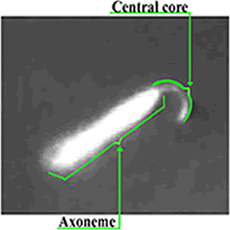Preface | Introduction to Problem Solving | Problem Sets | Acknowledgments
|
E.3. Isolated Flagella <<Previous Problem Next Problem>> |
PPDF |
| The whip-like structure and motility of sperm and algal
flagellae are complex and the relationship of structure to function
is poorly understood. To investigate these phenomena, scientists have
successfully removed intact flagellae from the cell bodies and then
manipulated them in various ways, including stripping them of their
plasma membrane envelopes. These isolated axonemes can then be further
dissected with proteolytic enzymes and their behavior observed with
high resolution, dark-field microscopy and recorded with an image-intensified
digital camera. When the media is manipulated appropriately these
modified axonemes continue to beat, but with time the axoneme core
becomes extruded and the beating of the entire axoneme slows and stops.
One such preparation, made by Omoto, et al. (1999 Mol. Biol.
Cell. 10:1-4. PMID9880321),
is depicted below in the labeled figure on the left, which shows a
single axoneme with its thinner central core extruded and slightly
curled (from the right-hand end). The blunt base of the axoneme (on
the left) is attached to the glass slide.
Double-click the figure to bring up the video by Omoto, et al. (1999) and examine the motion of the axoneme and its displaced core. Assuming the behavior of this in vitro preparation resembles the more normal motion of the intact flagellum in vivo, answer the questions posed in the right-hand frame below. [You can find out more about the mechanism of eukaryotic flagellar movement in Omoto, et al. 1999. Mol. Biol. Cell. 10:1-4. PMID9880321 (PubMed ID number)]
|
||
|
Questions
1. What is the flagellar axoneme? Illustrate your description with a well-labeled, cross-sectional view, which indicates which component(s) form the “central core.” 2. What chemicals must be present to elicit motility in this preparation? 3. How are flagellae thought to move? Briefly describe the mechanism and provide one piece of experimental data in its support. |
|
|
4. What aspects of flagellar motility are currently not well understood or not adequately explained by the mechanism you described above? 5. Carefully describe the axonmene and core behavior in the video. Based on your answers to the first two questions above, hypothesize how the core behavior might contribute to flagellar movement. |
||
